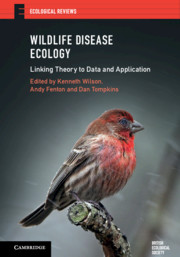Book contents
- Wildlife Disease Ecology
- Ecological Reviews
- Wildlife Disease Ecology
- Copyright page
- Contents
- Contributors
- Preface: Wildlife Disease Ecology
- Glossary of Terms
- Part I Understanding within-host processes
- Part II Understanding between-host processes
- Part III Understanding wildlife disease ecology at the community and landscape level
- Chapter Fifteen The ecological and evolutionary trajectory of oak powdery mildew in Europe
- Chapter Sixteen Healthy herds or predator spreaders? Insights from the plankton into how predators suppress and spread disease
- Chapter Seventeen Multi-trophic interactions and migration behaviour determine the ecology and evolution of parasite infection in monarch butterflies
- Chapter Eighteen When chytrid fungus invades: integrating theory and data to understand disease-induced amphibian declines
- Chapter Nineteen Ecology of a marine ectoparasite in farmed and wild salmon
- Chapter Twenty Mycoplasmal conjunctivitis in house finches: the study of an emerging disease
- Chapter Twenty-one Processes generating heterogeneities in infection and transmission in a parasite–rabbit system
- Chapter Twenty-two Sylvatic plague in Central Asia: a case study of abundance thresholds
- Index
- Plate Section (PDF Only)
- References
Chapter Nineteen - Ecology of a marine ectoparasite in farmed and wild salmon
from Part III - Understanding wildlife disease ecology at the community and landscape level
Published online by Cambridge University Press: 28 October 2019
- Wildlife Disease Ecology
- Ecological Reviews
- Wildlife Disease Ecology
- Copyright page
- Contents
- Contributors
- Preface: Wildlife Disease Ecology
- Glossary of Terms
- Part I Understanding within-host processes
- Part II Understanding between-host processes
- Part III Understanding wildlife disease ecology at the community and landscape level
- Chapter Fifteen The ecological and evolutionary trajectory of oak powdery mildew in Europe
- Chapter Sixteen Healthy herds or predator spreaders? Insights from the plankton into how predators suppress and spread disease
- Chapter Seventeen Multi-trophic interactions and migration behaviour determine the ecology and evolution of parasite infection in monarch butterflies
- Chapter Eighteen When chytrid fungus invades: integrating theory and data to understand disease-induced amphibian declines
- Chapter Nineteen Ecology of a marine ectoparasite in farmed and wild salmon
- Chapter Twenty Mycoplasmal conjunctivitis in house finches: the study of an emerging disease
- Chapter Twenty-one Processes generating heterogeneities in infection and transmission in a parasite–rabbit system
- Chapter Twenty-two Sylvatic plague in Central Asia: a case study of abundance thresholds
- Index
- Plate Section (PDF Only)
- References
Summary
Parasitism can affect every aspect of wildlife ecology, from predator avoidance and competition for food to migrations and reproduction. In the wild, these ecological effects can have implications for host fitness and parasite dynamics. In contrast, domestic environments are typically characterised by high host densities, low host diversity, and veterinary interventions, and are not subject to processes like predation, competition, and migration. When wild and domesticated hosts interact via shared parasite populations, understanding and predicting the outcomes of parasite ecology and evolution for wildlife conservation and sustainable farming can be a challenge. We describe the ecology and evolution of ectoparasitic sea lice that are shared by farmed and wild salmon and the insights that experiments, fieldwork, and mathematical modelling have generated for theory and applied problems of host–parasite interactions over the course of a long-term study in Pacific Canada. The salmon–sea lice host–parasite system provides a rich case study to examine the ecological context of host–parasite interactions and to shed light on the principal challenges of parasite management for wildlife health and conservation.
Keywords
- Type
- Chapter
- Information
- Wildlife Disease EcologyLinking Theory to Data and Application, pp. 544 - 573Publisher: Cambridge University PressPrint publication year: 2019
References
- 1
- Cited by



